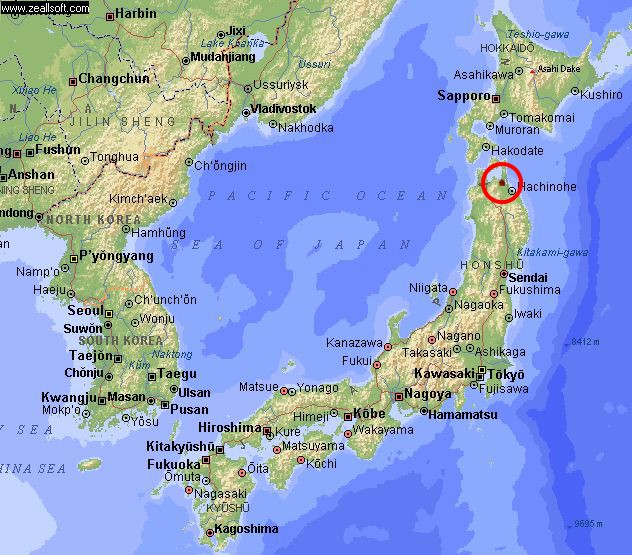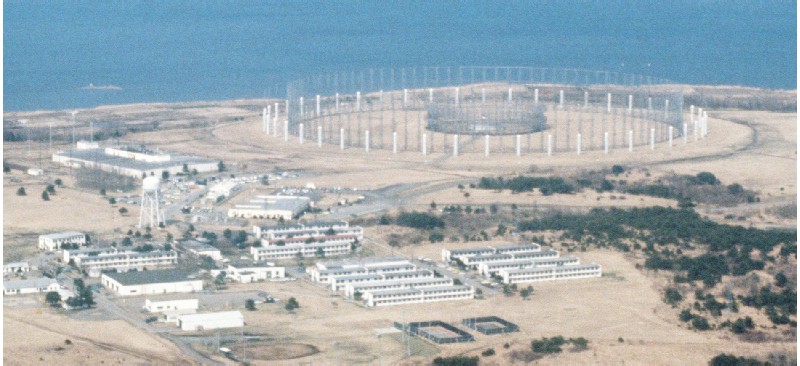
TARGET 091125
"The Elephant Cage"

If you've already done the dowsing, then you know (I hope) that this is in Japan. But where in Japan? It is on the far northern coast of the main island.
FEEDBACK MAP

"What?" you say, "There aren't any elephants in Japan!". Right you are. This is an elephant cage in name, only. It is actually an all-band radio antenns, affectionately called "The elephant cage" because it's real designation, "ANFLR-9 Antenna Array" is a lot harder to say. Besides, U.S. soldiers tend to give pet names to just about everything, anyway.
To give you an idea of the size of the antenna.....

The picture above shows the military installation where "The Elephant Cage" is located. Those are two- and three-story buildings in the foreground, about half a mile closer to the camera than the center of the antenna is.
During the cold war, there were several of these antennae around the world, but now, there are only two. This one is located a few miles north of Misawa, Japan, at the northern end of Misawa Air Force Base.
The AN/FLR-9 is a type of very large circular "Wullenweber" antenna array, built at many locations during the cold war for HF/DF direction finding of high priority targets. The worldwide network, known collectively as "Iron Horse", could locate HF communications almost anywhere on the planet.
The facility you see in the above picture is one of the U.S. military's "listening posts". The antenna is positioned to pick up all radio signals from Asia and the Pacific Theater, but the antenna is so sensitive that it can also pick up signals from around the world, if the "skip" is right. The fact that it has sub-antennas in a complete circle also lets operators inside know the direction from which the signal is coming. Two such antennas can be used to triangulate the sending radio's position down to within a very small area.FOR BASIC-LEVEL VIEWERS
I hope that, while viewing this target, you got the concentric circles (the antenna was the target), and the nearby water, as well as some associated buildings on the other side of the circles than the water is (phase 3 work). If you also got the correct purpose, some of the activities, physical descriptions of the people, area, or other details about the target, then you're doing great.
FOR THE ADVANCED VIEWERS
(who should have been curious enough about the circles they were getting to seek out all kinds of details about them)...The AN/FLR-9 Operation and Service Manual[1] describes the array as follows: "The antenna array is composed of three concentric rings of antenna elements. Each ring of elements receives rf signals for an assigned portion of the 1.5 to 30-MHz radio spectrum. The outer ring normally covers the 2 to 6-MHz range (band A), but also provides reduced coverage down to 1.5 MHz. The center ring covers the 6 to 18-MHz range (band B) and the inner ring covers the 18 to 30-MHz range (band C). Band A contains 48 sleeve monopole elements spaced 78.4 feet apart (7.5 degrees). Band B contains 96 sleeve monopole elements spaced 37.5 feet (11.43 m) apart (3.75 degrees). Band C contains 48 antenna elements mounted on wooden structures placed in a circle around the central building. Bands A and B elements are vertically polarized. Band C elements consist of two horizontally polarized dipole antenna subelements electrically tied together, and positioned one above the other."
The array is centered on a ground screen 1,443 feet (439.8 m) in diameter. The arrangement permits accurate direction finding of signals from up to 4000 nautical miles (7 408 km) away.On a personal note..
My students know that I was the only Mongolian linguist in the U.S. military for a while, and this is where I learned to use the language. I worked at this facility for a period of four years as a Russian & Mongolian linguist. It was from living in Japan that I also learned Japanese.
The pictures above show the antenna in the summertime, but during the fierce nothern Japanese winters, the snow can get up to 6 or 8 feet deep, and make travel from main base to the facility an exercise in discriminating white-from-white, to decide which white is the road and which white isn't. During the snowy months, 8-foot tall, candy-striped "snow poles" are placed along the roads, so you will have a guide, but by the depths of winter, the poles are often covered by snow, as well. Because of its northern latitude, during the summer, the sun comes up by 2:30 AM, and doesn't set until around 11PM at night. During the winters, daylight is only around for a short while each day.
There are approximately 20 minor-to-major earthquakes each day in northern Japan. Almost all of them are so small that they can't be felt. Dogs will sometimes look down and bark at the ground, but that is the only indication that a small earthquake is happening. I was on "Charge of Quarters" duty one night, to man the emergency phones. Most of the night, I had nothing to do except read a book and play pool. Playing pool there was a little more difficult than elsewhere, because when one of the minor earthquakes happened, the balls would suddenly roll back and forth and reposition themselves across the table, seemingly acting on their own.
If you tried describing the people there, they are all military - from every U.S. branch of military service. They work "6 and 2 rotating shift", where you work six days on, have a day and a half off and then six "graveyard" shifts, then a day and a half off and then six evening shifts, then a day and a half off and ...... you get the idea. Why the military holds to this work schedule is beyond anyone's comprehension. Because of this gruelling schedule, worked for 3 to 4 years, without relief, the people there are almost always weary and tired, bringing up yet another example of why any time you try describing the people at a target site, you should just give physical descriptions, and not try to get into their minds, "feel their emotions", or try to mentally meld with them in any way. This is a tiredness that sets deeply into a person, and it can take a very long time to get over. When viewing people - stay out of their minds.
Several miles from this facility is Misawa Air Force Base, which is presently an active air base. Right outside the base gates is Misawa, Japan, a great Japanese community which is very friendly to the U.S. presence there. We had many friends in the Japanese community, and learned the area well. In our four years there, we learned where all the interesting sites, restaurants, shops, temples, and other places were, and acted as "introducers to the community" for newly arriving personnel and their families throughout our stay. It is a lovely place where all military intelligence people want to be assigned. So in demand is it that the general, unofficial policy is that nobody gets a second assignment there, in order to let others have the opportunity to experience the place. My entire family and I have very fond memories of Misawa. It was one of those places where, if we ever got a chance to go back, we definitely would.If you gained information in your session which was not covered in the feedback, please take a look at these sites:
Wikipedia
The operations and service manual
Wullenweber antennas
The Misawa AFB home page